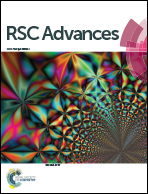Band gap and morphology engineering of TiO2 by silica and fluorine co-doping for efficient ultraviolet and visible photocatalysis
Abstract
Silicon and fluorine co-doped anatase TiO2 (Si–F–TiO2) photocatalysts with enhanced photocatalytic activity were successfully prepared via a facile two-step synthetic method by using SiO2 powders and (NH4)2TiF6 as the precursors. The obtained products were thoroughly characterized using various techniques, including scanning electron microscopy (SEM), transmission electron microscopy (TEM), X-ray diffraction (XRD), X-ray photoelectron spectroscopy (XPS), UV-visible diffuse reflectance spectroscopy and N2 adsorption–desorption analysis. The characterization revealed the effects of molar ratio of silica to titanium (R) and pH value on morphology, size and crystal structure of Si–F–TiO2 samples. We find that the band gap of the catalyst can be engineered from 3.16 to 2.88 eV via altering the molar ratio of Si : Ti and the pH value. Compared with un-doped or F-doped TiO2, co-doped Si–F–TiO2 samples exhibited improved photocatalytic degradation toward different dye molecules under both ultraviolet and visible light illumination. With the aid of hole and radical trapping experiments, we proposed a photocatalytic mechanism for the examined systems. Furthermore, first-principle calculations provide theoretical insights for the enhanced photocatalytic performance of codoped Si–F–TiO2 photocatalyst.


 Please wait while we load your content...
Please wait while we load your content...